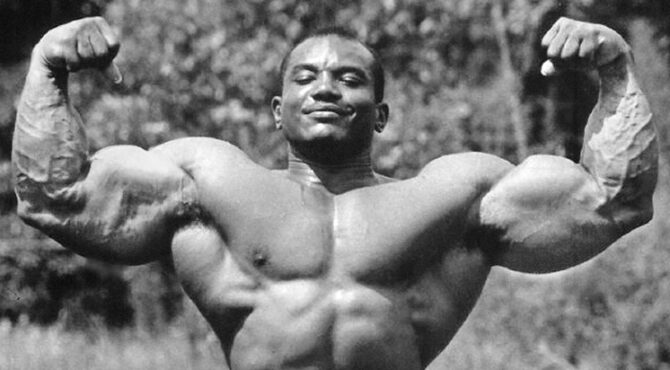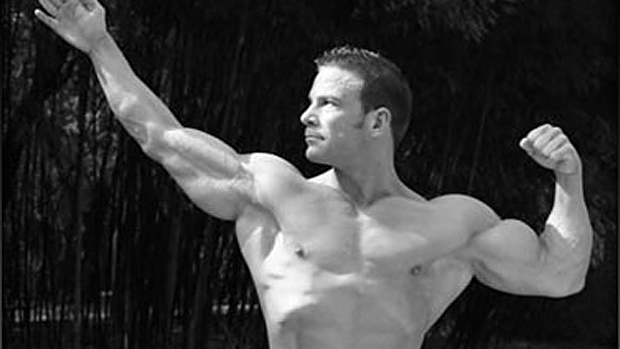Sergio Oliva, 1971.
Ellington Darden is a fitness legend that rose to notoriety in 70s, 80's, and 90's. You may not recognize his name, but you've undoubtedly used exercise techniques or principles he developed. You need to read this article — word for word.
I'm a treasure hunter. I've devoted my education, career, and entire adult life looking for something that I'd already found 47 years ago — but didn't realize it until recently. I'm exhilarated with finally seeing the treasure, but I'm also frustrated and angry that I wasn't able to enjoy the exploits of my discovery over the last 47 years.
My treasure is muscle — not just muscle, but the hidden principles for building muscle fast. I'm not claiming that I've found the very best way and that nothing else will ever top it. There's no way to prove that. However, I am telling you that I've never seen anything else close to it in all of my 50 years devoted to elite-level fitness — and I've seen and tried just about everything.
I trained some of the most genetically gifted bodybuilders who've ever lived. This discovery would've been of tremendous value to them, but that's not where my interest lies. I would consider it my most significant accomplishment if I provided a doable clear path to success for the millions of people who'll never stand on stage or be competitive athletes.
Regardless of your genetic gifts or fitness levels, I believe I can now show anyone how to rapidly build muscle while developing elite-level fitness from the same workouts. I've found there's a distinct synergy between the muscle and fitness goals — that you get better muscle gains when done together in the same activity than when worked separately.
I promise to deliver possibly the most revealing information you've ever read about the subject, and I'll provide an exercise plan so you can get started right away. But I need to first put all of this in context for clarity. So please carefully read the next several sections before getting to the good part.
I first had the idea for metabolic challenges in 1974. I was at the Super Bowl in Houston, Texas, where the Miami Dolphins beat the Minnesota Vikings 24-7. But the game was long with little excitement.
The Dolphins could've won by more than 50 points — and they should've — but they didn't. What did they lack? They lacked the metabolic conditioning required for sustained high-level offensive drives.
At that time, I was director of research for Nautilus Sports/Medical Industries. I realized at the game that the answer I was looking for had to be a unique type of no-rest strength training that built muscle while conditioning the body.
"How can you build muscle, increase strength, reach your highest level of performance capacity, and then go even higher — all from the same workouts?"
That was the question that led me to develop metabolic challenges for building muscle.

Nautilus had the resources to fund a study at a major university to demonstrate the effects of training with no rest between exercises. We could then show that brief high-intensity workouts on Nautilus machines could increase muscular strength, joint flexibility, and cardiorespiratory endurance from the same workout.
The label Nautilus gave to the concept was "metabolic conditioning." Metabolic conditioning, we thought, would produce a level of muscular development and human performance that would be unmatched by any other training form.
In 1975, Nautilus did the study at the U.S. Military Academy at West Point. The 19 Army football players in the metabolic challenge group trained three times per week on Nautilus machines, with no rest between exercises. The standard training group consisted of 16 Army football players who used free weights and traditional strength training methods, but they added rest periods between sets.
Both groups were tested several different ways and included a 2-mile run. The study lasted six weeks, and the overall results were overwhelming in favor of the metabolic challenge group. Here are the strength gains and 2-mile run improvements:
| Strength Gains | Results |
|---|---|
| Metabolic challenges | 59% strength increase |
| Standard training | No significant strength increase |
| 2-Mile Run | Results |
|---|---|
| Metabolic challenges | 88-seconds faster time |
| Standard training | 20-seconds faster time |
Even with those superior results, I didn't realize just how essential the workout pace was and how it synergized muscle gains. In four years, it was dropped from the Nautilus principles. Instead, we focused on Nautilus machine efficiency, using good form, and pushing people harder toward exercising to failure.
Form began to erode when most trainees found it easier to show "progress" if they cheated on exercise form and rested between exercises. Both practices allowed for heavier and heavier weights to be lifted without any real progress being made.
Poor exercise form and training to failure sadly remained the only mainstays of the original Nautilus principles. It was a painful and tedious protocol that produced minimal results.

Metabolic conditioning became the forerunner of metabolic challenges. I've found that using the fully developed metabolic challenge principles quickly builds high-performance muscle mass. The kind required for relentless brute drive on the athletic field or in everyday life.
Training to failure was a practice I wish I could've stopped in the '80s and replaced with this much more productive exercise prescription. Training to failure actually limits the number of muscle fibers stimulated. I suspected then and now know that you can stimulate more muscle fibers and make a deeper inroad by applying specialized loading methods such as 30-10-30 and stopping one or two repetitions short of failure.
It's a more effective way to train and less taxing on your nervous system. You stimulate more muscle fibers, avoid overtraining, recover faster, and can exercise more frequently. Together, this produces the fastest and greatest gains I've ever experienced.
17 Pounds in 14 Workouts
I recently trained my 18-year-old son Tyler, using these exact principles, for the 30-10-30 project. In 14 workouts, Tyler got in superior athletic condition and gained 17 pounds of lean mass — and I never once increased his exercise weights.
Here are the new principles that should've been implemented 47 years ago:
- Perfect Exercise Performance. Be passionate about perfect exercise performance. Move smoothly through the full range. Be mindful of your efforts and focus your thoughts on contracting and un-contracting muscle fibers, nothing else. Treat each exercise for what it really is: an event — a muscle event.
- Challenging Workout Pace. View the whole workout as a timed challenge. After each exercise, switch your attention to the pace, and quickly move to the next lift. If you're not fighting your will to rest, you're taking too much time.
- Emphasize the Last Rep. The last rep is the most important, and needs to be the best quality repetition of the set. Understand that YOU are the arbiter of which rep is the last one; make your choice wisely. Regardless of the target count, NEVER start a rep that you can't guarantee a perfectly executed full-range completion. Excessive struggling, twisting, grunting, and contorting is not the way to end an exercise. Conclude each set with a composed execution, as if a panel of expert judges were scoring your performance.
- Optimal Resistance. Select a weight that allows you to hit the prescribed rep numbers using perfect form on every rep, especially the last one. The goal is to stick with a weight until it becomes OBVIOUSLY too light. That's when to increase resistance. Purposely go lighter on new exercises to better learn the movement pattern and to take advantage of the new-adaptation effect. If you can't hit the target rep count, lower the weight. If resistance it obviously too easy, add just enough to make it challenging.
- Advanced Loading Methods. The system uses a variety of loading methods that exploit one or more of the four contraction types: positive, negative, static, and loaded stretches. Knowing how to manage loading methods is the essence of coaching and requires advanced understanding of the system.
- Planned Variety. The body is designed to adapt, and you have to stay ahead of adaptation to avoid stagnation. You need to follow a plan designed with optimal variety for keeping the body adapting. Switching loading methods is the best variety component. Exercises can remain the same.
- Three Full-Body Workouts. Do no more than three (nonconsecutive) workouts per week. I've tested all types of training schedules and three days per week works the best. If you want to train more often, use another system.
- Time/Volume Progression. I often prefer four-week training cycles. Start week one with six exercises and add one more each workout each week for four weeks (6, 7, 8, 9). At the same time, decrease the time between exercises each week by few seconds. For beginners, start with 30 seconds between exercises and reduce the time by 5 seconds each week (30, 25, 20, < 20). Advanced trainees could start with 20 seconds and end with < 10 seconds on week four (20, 15, 10, < 10). Time/volume progression should always be used. Once you get to the end of a program, start back at six exercises with 15-20 seconds time in-between.
- Gains Week. I've found that a lot of the biggest gains come when backing off after a program. So use the week after a program for a gains week. Do only two workouts that week and use special loading methods that pump muscle with nutrients to facilitate gains.
- Fuel Growth. Consume generous amounts of water and peri-workout nutrition to fuel growth and facilitate recovery. Loading the body with key nutrients before each session significantly improves workout performance, recovery, and the rate of progress.

I've used variations of the chin, dip, run cycle to get many athletes in top shape. It's highly effective for metabolic conditioning while building muscle, and can be done just about anywhere. All you need is a chin bar, dip station or parallel bars, and a 40-yard clear path for sprints.
You're going to do a chin-sprint cycle for 60 seconds followed by a dip-sprint cycle 60 seconds, with no rest between the exercises or cycles. The first week consists of three compete rounds, consisting of 3 sets of chins and dips and 3 sets of sprints. You'll add an extra double-cycle each week for four weeks. The goal is to be able get 6 complete double-cycles in 12 minutes. If you can do that, you are an incredible athlete.
- Chins: Do 5 smooth reps, going 2 seconds up and 2 seconds down, with a 1-second hold in the TOP position of every rep. Do a 15-second negative (lowering) phase on the fifth and final rep of each set The goal is to get all five reps in exactly 40 seconds. Friday's session will include a 1-second hold in the mid position (instead of the top) during the negative phase of each rep.
- Dips: Do 5 smooth reps, going 2 seconds up and 2 seconds down, with a 1-second hold in the BOTTOM position of every rep. Do a 15-second negative (lowering) phase on the fifth and final rep of each set The goal is to get all five reps in exactly 40 seconds. Friday's session will include a 1-second hold in the mid position (instead of the bottom) during the negative phase of each rep.
- Run: Run 40 yards at about 80% effort, turn around, and run 40 yards back to the start. You have 20 seconds to complete the complete 80-yard run (40 yards down and back).
The Wednesday workout is different from the Chin, Dip, Run cycle. It's a single-joint workout consisting of the following five exercises:
- Lateral Raise
- Dumbbell Biceps Curl
- Overhead Dumbbell Triceps Extension
- Reverse Barbell Curl
- Reverse Trunk Curl on Floor
Do one set of 8 repetitions and move 20 seconds or less between exercises. Add 2 reps to each exercise on the following Wednesday and another 2 reps the next Wednesday. During week 4, do 12 reps and a final 30-second lowering on each exercise.
Monday
| Exercise | Method | Time |
|---|---|---|
| Cycle 1 | ||
| Chin | 5 x 2 sec. up / 2 sec. down with hold at TOP, 15-sec. neg. last rep | 40 seconds |
| Run | 80% x 40 yards down, 40 yards back | 20 seconds |
| Dip | 5 x 2 sec. up / 2 sec. down with hold at BOTTOM, 15-sec. neg. last rep | 40 seconds |
| Run | 80% x 40 yards down, 40 yards back | 20 seconds |
| Cycle 2 | ||
| Chin | 5 x 2 sec. up / 2 sec. down with hold at TOP, 15-sec. neg. last rep | 40 seconds |
| Run | 80% x 40 yards down, 40 yards back | 20 seconds |
| Dip | 5 x 2 sec. up / 2 sec. down with hold at BOTTOM, 15-sec. neg. last rep | 40 seconds |
| Run | 80% x 40 yards down, 40 yards back | 20 seconds |
| Cycle 3 | ||
| Chin | 5 x 2 sec. up / 2 sec. down with hold at TOP, 15-sec. neg. last rep | 40 seconds |
| Run | 80% x 40 yards down, 40 yards back | 20 seconds |
| Dip | 5 x 2 sec. up / 2 sec. down with hold at BOTTOM, 15-sec. neg. last rep | 40 seconds |
| Run | 80% x 40 yards down, 40 yards back | 20 seconds |
| Total Time | 6 minutes | |
Wednesday
| Exercise | Method | Time |
|---|---|---|
| Lateral Raise | 1 x 8 reps 2 seconds up and 2 seconds down | < 20 seconds |
| Dumbbell Biceps Curl | 1 x 8 reps 2 seconds up and 2 seconds down | < 20 seconds |
| Overhead Dumbbell Triceps Extension | 1 x 8 reps 2 seconds up and 2 seconds down | < 20 seconds |
| Reverse Barbell Curl | 1 x 8 reps 2 seconds up and 2 seconds down | < 20 seconds |
| Reverse Trunk Curl on Floor | 1 x 8 reps 2 seconds up and 2 seconds down | Finished |
Friday
| Exercise | Method | Time |
|---|---|---|
| Cycle 1 | ||
| Chin | 5 x 2 sec. up / 2 sec. down with hold at MID pos., 15-sec. neg. last rep | 40 seconds |
| Run | 80% x 40 yards down, 40 yards back | 20 seconds |
| Dip | 5 x 2 sec. up / 2 sec. down with hold at MID pos, 15-sec. neg. last rep | 40 seconds |
| Run | 80% x 40 yards down, 40 yards back | 20 seconds |
| Cycle 2 | ||
| Chin | 5 x 2 sec. up / 2 sec. down with hold at MID pos, 15-sec. neg. last rep | 40 seconds |
| Run | 80% x 40 yards down, 40 yards back | 20 seconds |
| Dip | 5 x 2 sec. up / 2 sec. down with hold at MID pos, 15-sec. neg. last rep | 40 seconds |
| Run | 80% x 40 yards down, 40 yards back | 20 seconds |
| Cycle 3 | ||
| Chin | 5 x 2 sec. up / 2 sec. down with hold at MID pos, 15-sec. neg. last rep | 40 seconds |
| Run | 80% x 40 yards down, 40 yards back | 20 seconds |
| Dip | 5 x 2 sec. up / 2 sec. down with hold at MID pos, 15-sec. neg. last rep | 40 seconds |
| Run | 80% x 40 yards down, 40 yards back | 20 seconds |
| Total Time | 6 minutes | |
| Period | Volume | Total Time |
|---|---|---|
| Week 1 | 3 Cycles | 6 minutes |
| Week 2 | 4 Cycles | 8 minutes |
| Week 3 | 5 Cycles | 10 minutes |
| Week 4 | 6 Cycles | 12 minutes |
| Period | Volume | Rest |
|---|---|---|
| Week 1 | 1 x 8 reps | < 20 seconds |
| Week 2 | 1 x 10 reps | < 20 seconds |
| Week 3 | 1 x 12 reps | < 20 seconds |
| Week 4 | 1 x 12 reps, 30-second negative on last rep | < 20 seconds |
For a full training program, check out Ellington Darden's 30-10-30: Metabolic Challenges for Building Muscle below:





